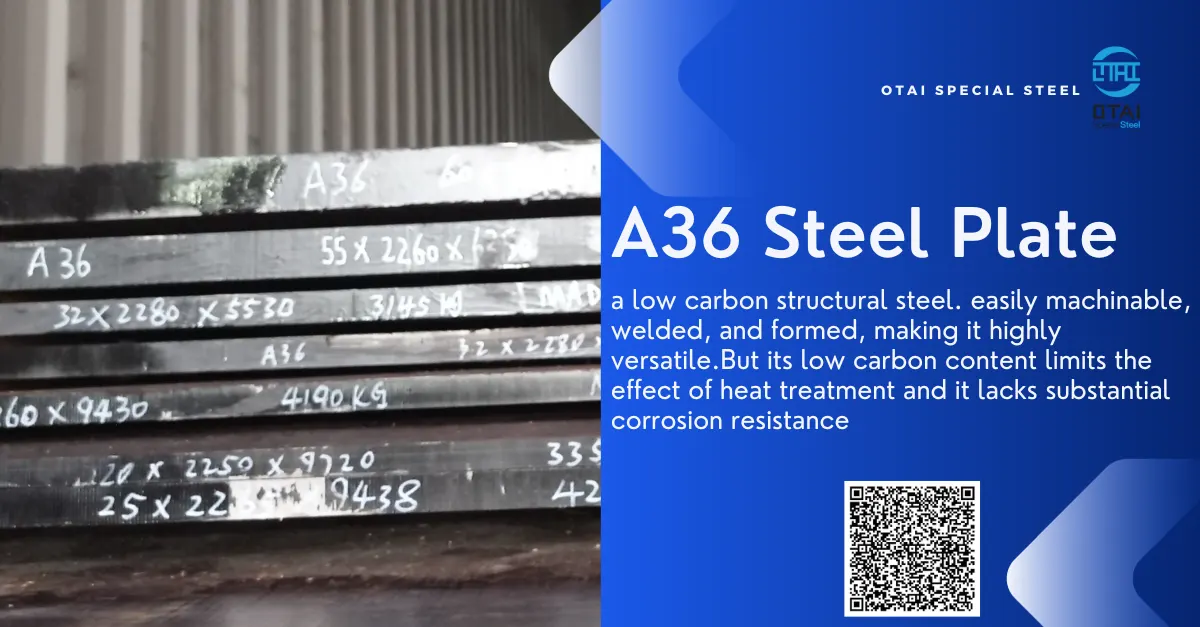1. What is A36 Steel
A36 steel, a low carbon structural steel, is important in the construction and manufacturing industries. It’s characterized by its less than 0.3% carbon content by weight,
- A 36 steel is easily machinable, welded, and formed, making it highly versatile.
- Its low carbon content limits the effect of heat treatment.
- lacks substantial corrosion resistance due to no nickel and chromium.

2. Supply Range of A36 Steel
- Round Bar: 16-300mm diameter, standard length 6-9 meters.
- Steel Plate: 14-200mm hot rolled available in stock.
- Surface: black surface
3. A36 Steel Specifications and Equivalent Steel Grades
| A 36 Specification | Equivalent Steel Grades |
|---|---|
| ASTM A36 | S235JR, SS400, Q235, ST37-2, S235J2, Q235D |
4. A 36 Steel Chemical Composition
| Element | A-36 Composition (%) |
|---|---|
| Carbon | 0.25 – 0.29 |
| Manganese | 1.03 |
| Silicon | 0.28 |
| Phosphorus | 0.04 |
| Sulfur | 0.05 |
| Copper | 0.20 |
| Iron | 98% |
5. A36 Material Properties
A36 steel’s mechanical properties:
- yield strength of 36,000 psi
- ultimate tensile strengths ranging from 58,000 to 79,800 psi.
- elongate to about 20% of its original length under tensile testing, providing excellent impact strength at room temperature.
- density of 2.84 lb/in^3,
- hardness of 67–83 Rockwell
- machinability rating of 72%
6. Forging and Forming of A 36 Steel
A36 steel is typically hot rolled, which imparts strain on the steel, increasing dislocation density and resulting in work hardening. The hot rolling process also creates grain elongation, offering a rougher surface finish but at a lower cost compared to cold rolling.
7. Heat Treatment of A36 Sheet
The annealing of ASTM A36 material is performed at temperatures ranging from 1,550 to 1,600°F. This process decreases brittleness, reduces hardness, and affects the steel’s microstructure by recrystallization. The specific cooling rate controls the growth of new grains, limiting internal stresses in the A36 steel.
8. Applications of A36 Plate and Round
A36 material is widely used in infrastructure, like bridges and buildings, because of its high strength, weldability, formability, and malleability. It also finds applications in the automotive, construction, heavy machinery, and oil & gas industries. It’s popular in different industries because of the low price and versatile properties.
9. With Otai and A36 Steel
A36 steel is an versatile material in the construction and manufacturing industries, known for its strength, versatility, and economic viability. While it has some limitations like lower corrosion resistance, its wide range of applications in structural and industrial projects makes it a valuable choice for engineers and builders.
Otai keeps over 1000 tons of A36 steel plate for immediate delivery with attractive price. You are welcome to send us the inquiries anytime by email jeremy@otaisteel.com or WhatsApp.
FAQs About A36 Steel
- How does A36 steel’s low carbon content affect its properties? A36’s low carbon content enhances its machinability and weldability but limits the effectiveness of heat treatment and corrosion resistance.
- What are the main applications of A36 plates? A36 plates are primarily used in structural applications in buildings, bridges, and oil rigs, as well as in automotive and agricultural applications.
- How is A36 carbon steel made? A36 material is made by melting iron ore with coal, burning away impurities, adding alloying elements like manganese and carbon, solidifying into ingots, and then hot rolling.
- What are the limitations of A36 carbon steel? The main limitations include its low strength-to-weight ratio, lower strength compared to 1018 steel, and difficulty in accurately determining its precise carbon content.
- Can A36 engineering steel be used in high-stress applications? Yes, A36’s combination of machinability, strength, and durability makes it ideal for high-stress applications like bridge and building construction.
